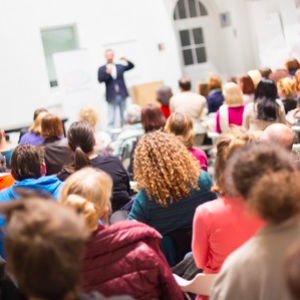10 ways to be a good audience member at conventions

Convention season will soon be here again in full force, with professionals flocking to national conferences for learning and networking. Unfortunately, some convention goers don’t know—or don’t follow—proper etiquette when attending conventions, or even how to leverage their time to best benefit their companies or careers.
Here are 10 tips on how to get the most out of your conference experience while demonstrating courtesy to presenters and fellow attendees.
Be sure to catch what my “I-Can’t-Believe-He-Wrote-Me-Back” source said in #8.
1. Take pictures, but only during the first few minutes of a presentation. It’s exciting when the anticipated speaker finally begins the long-awaited workshop, and the room may be abuzz. This is the time to raise your device and snap a few images. Once you have your picture of the presenter, you won’t get anything visually different throughout the speech unless they start juggling or riding a unicycle…so there is no need to keep taking photos. Sure, you can take pictures of certain slides throughout the workshop, but do so discretely so as to not disturb others or block their view. (See this post on how a professional photographer approaches high-profile speech photography)
2. Audience Q & A is not a time for you to offer a rambling soliloquy. An effective question contains one or two sentences setting the premise and then a sentence with the question.
Also, a question does not end with a trailing “or,” such as, “Do you think these trends will continue…or…?” You’ll sound more confident and polished by eliminating “or” as the final word of a question.
3. Have fun on social media. Post quotes you like, include hashtags about the topic, and tag the presenter. This will establish a dialogue that can continue well after the convention is over. You never know where it might lead.
4. Layers. When going to over-air-conditioned conference rooms, even in the summer, remember to bring warm clothes. Many of you have already learned this one the hard way on your own.
5. Take notes and publish on a blog. You’ll want to remember what you learned. So take notes and create a series of blog posts for the convention, whether on your company or personal blog. You can write a new post each day summarizing key points from each workshop. Forward the link to your boss and colleagues back home. If you’re a solo practitioner, you’ll be able to refer to these notes easily. If you don’t have a blog yet, go on Blogger and create something like, “Mr. Oliver goes to Boston for PRSA2017.” Include some of the photos you’ve taken in each post. Research shows that adding a visual element always gets more interest.
6. Be on time to the workshop. Please don’t come bustling in five minutes after a legend has begun speaking. If you are indeed late, please don’t traipse all the way to the front row to find empty seats.
7. There is such a thing as a dumb question. If you raise your hand in the middle of a presentation about social media to ask “what is ‘tagging?’” (yep, I really saw this happen recently), you’re letting everyone know they shouldn’t approach you after the meeting for business opportunities. Instead, quietly ask the person next to you. Even better, look it up.
If a presenter is truly confusing the audience, then you or someone else could briefly ask for a point of clarification, but I otherwise prefer the traditionally Asian culture’s approach to presentations—let the speaker deliver their speech and hold your questions until the end.
8. Talk to the speaker after the presentation, but only for a moment. Be aware that other people are waiting to do the same. The speaker wants to meet many people and make connections—not take 10 minutes to explain to you individually what hashtags are.
Even better, take the advice from David Meerman Scott (!!!), frequent speaker and author of the excellent “The New Rules of Marketing & PR, 5th Edition.” I showed him a preview draft of this article, and he suggested: “Talk to the speaker BEFORE the presentation. There is no line and you can get five or even 10 minutes. Afterward, you’re lucky to get 30 seconds.”
9. Bring business cards. Enjoy learning about other attendees, either while strolling the exhibit hall or while sitting next to them in workshops. But be sure to exchange cards or share contact information electronically at some point in the conversation, because you never know where those connections might lead.
10. Plenary sessions are optional; workshops are mandatory. I list this point with the caveat that it depends on the convention. Too often, the plenary session keynotes at huge conferences feature a celebrity or media personality with little connection or expertise on the industry or topic. They were brought in to put on the marquee, and their speech is most likely too general to be useful. Use your time at the convention wisely. This may include skipping plenary sessions you deem irrelevant so can do other things, such as explore opportunities in the exhibit hall or work on your convention blog. You may even wish to sleep in—your body might need extra rest if you’re out of your home time zone. Workshops, however, are generally excellent learning opportunities, and you should attend one during each time slot. That being said, once in a great, long while you’ll realize after 15 minutes that a workshop isn’t serving you. Walk out, go change into your workout clothes and go to the hotel gym—charge up for the next workshop.
Enjoy your convention and get the most out of it possible.
Any suggestions I missed? Anything you don’t agree with? Any humorous anecdotes you’d like to share? I welcome your feedback.
—Ansel Oliver is a manager for special projects at SnappConner PR.
